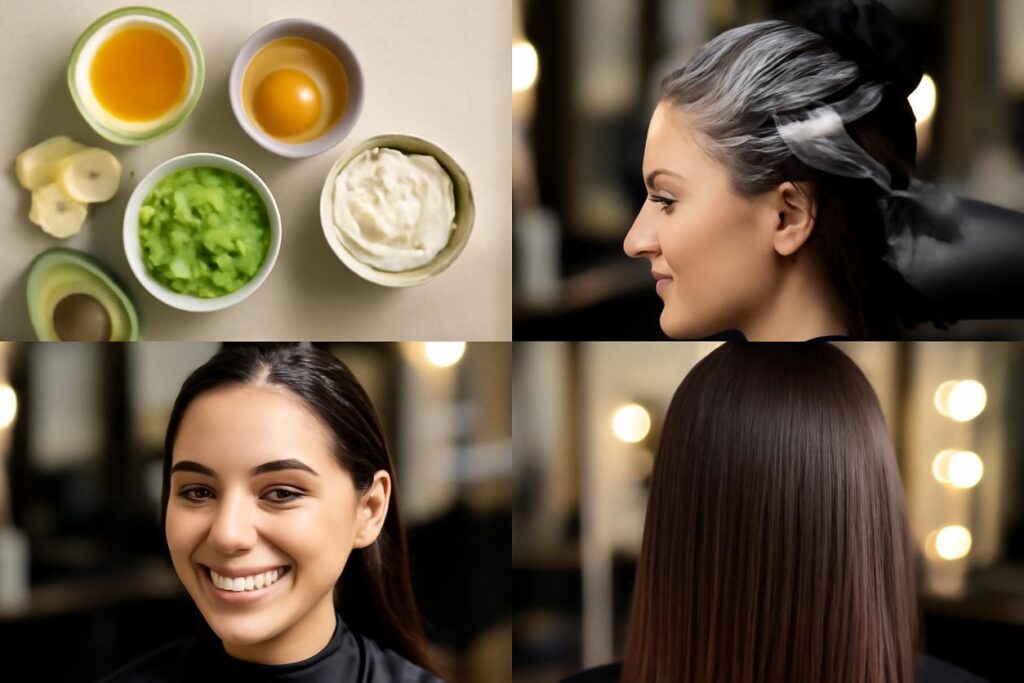Your Ultimate 2025 Guide to the Perfect DIY Hair Mask
Table of Contents
- Introduction – why homemade masks can work for you
- How hair structure shapes results
- Key ingredients to embrace and to avoid
- Five adaptable recipes mapped to hair types and concerns
- Preparation, application and rinse technique
- Troubleshooting common outcomes and fixes
- Safety guidance, patch tests and frequency
- Ingredient sourcing and sustainable swaps
- Integrating masks into a regular care routine
- FAQ
- References and further reading
Introduction – why homemade masks can work for you
In a world of endless hair care products with long, confusing ingredient lists, turning to your own kitchen can feel like a breath of fresh air. Creating a DIY hair mask is more than just a cost-saving measure; it’s an act of empowerment. It puts you in complete control of what you put on your hair, ensuring fresh, potent ingredients without unnecessary fillers, silicones, or harsh chemicals. Whether your hair is feeling dry, brittle, oily, or just a bit lackluster, the right homemade hair treatment can offer a targeted solution.
This comprehensive guide will walk you through the science of your hair, the power of natural ingredients, and customizable recipes to create the perfect DIY hair mask for your specific needs. Forget the one-size-fits-all approach. By 2025, personalized hair care is not a luxury, it’s a standard you can achieve right at home.
How hair structure shapes results
To create a truly effective DIY hair mask, you first need to understand the canvas you’re working on: your hair. Three fundamental characteristics—porosity, density, and elasticity—dictate how your hair will respond to different ingredients. Knowing these traits is the key to moving from random kitchen concoctions to targeted, effective treatments.
Porosity, density and elasticity explained
Think of these as your hair’s unique personality profile. Tailoring your mask to this profile will yield much better results.
- Porosity: This refers to your hair’s ability to absorb and retain moisture. It’s determined by the structure of your hair’s outer layer, the cuticle.
- Low Porosity: The cuticles are tightly packed and flat. This hair type resists moisture, making it prone to product buildup because treatments tend to sit on the surface. It is often healthy but can lack volume.
- High Porosity: The cuticles are raised or have gaps, either naturally or due to damage from heat or chemical treatments. This hair absorbs moisture easily but loses it just as quickly, leading to frizz and dryness.
- Density: This is simply the number of individual hair strands on your scalp. It’s different from the thickness of each strand. You can have fine hair with high density, or coarse hair with low density. Density affects how much product you’ll need to use to achieve full coverage.
- Elasticity: This measures the “stretchiness” of your hair. Healthy, well-moisturized hair has good elasticity; it will stretch and return to its original shape. Hair with poor elasticity feels brittle and snaps easily when pulled, often indicating a need for more moisture or a protein imbalance.
Key ingredients to embrace and to avoid
The heart of any great DIY hair mask is its ingredients. Just like with our diet, what we “feed” our hair matters. Understanding the roles of different oils, proteins, and moisturizers is crucial for building a balanced and effective mask.
Plant oils and when to choose them
Oils are fantastic for adding shine, softness, and strength, but not all oils work the same way. They generally fall into two categories: penetrating and sealing.
- Penetrating Oils: These have a smaller molecular structure, allowing them to absorb past the hair cuticle and moisturize from within. They are excellent for nourishing and strengthening the hair shaft. Choose these when your hair feels genuinely dry and brittle.
- Sealing Oils: These have larger molecules that sit on top of the hair shaft, creating a barrier that locks in moisture and smooths the cuticle. They are perfect for taming frizz and protecting hair, especially for high porosity types that lose moisture quickly.
| Oil Type | Examples | Best For |
|---|---|---|
| Penetrating | Coconut Oil, Olive Oil, Avocado Oil | Deep conditioning, strengthening, pre-shampoo treatments |
| Sealing | Jojoba Oil, Grapeseed Oil, Argan Oil | Locking in moisture, reducing frizz, adding shine |
Proteins and moisturizers: timing and balance
Hair is primarily made of a protein called keratin. When hair is damaged, it loses protein, creating gaps that lead to weakness and breakage. However, hair health is a delicate dance between protein and moisture.
- The Protein-Moisture Balance: This is the golden rule of hair health. Too much protein without enough moisture can make hair feel rigid and brittle. Too much moisture without a strong protein structure can leave hair feeling overly soft, limp, and “gummy.”
- DIY Protein Sources: Ingredients like Greek yogurt, eggs, and gelatin can temporarily patch the gaps in the hair cuticle, adding strength and structure. These are best for high porosity, color-treated, or heat-damaged hair.
- DIY Moisturizers (Humectants): Ingredients like honey, aloe vera gel, and vegetable glycerin are humectants, meaning they attract water from the atmosphere into the hair. They are fantastic for adding softness and elasticity.
- What to Use with Caution: While apple cider vinegar and lemon juice are often cited in DIY recipes, they are highly acidic. Using them undiluted or too frequently can disrupt the hair’s natural pH and cause dryness. Always dilute them heavily if you choose to use them as a final rinse, not as a core mask ingredient.
Five adaptable recipes mapped to hair types and concerns
Here are five foundational DIY hair mask recipes. Think of them as starting points. Feel free to adjust quantities based on your hair length and density.
Hydration formula for low porosity hair
This mask focuses on lightweight hydration that can penetrate tightly-bound cuticles without causing greasy buildup.
- Ingredients: 3 tablespoons of aloe vera gel, 1 tablespoon of honey, 1 teaspoon of argan oil.
- Method: Whisk ingredients together until smooth.
- Why it Works: Aloe vera and honey are powerful humectants that provide oil-free moisture. Argan oil is a light sealing oil that adds shine without weighing hair down.
Protein repair for high porosity or damaged hair
This protein-rich DIY hair mask helps fill in the gaps in the hair cuticle, temporarily strengthening strands and reducing frizz.
- Ingredients: 1 whole egg (or 3 tablespoons Greek yogurt), 1 tablespoon of olive oil, 1 teaspoon of honey.
- Method: Beat the egg thoroughly, then whisk in the olive oil and honey.
- Why it Works: The protein in the egg or yogurt provides structure, while olive oil nourishes and seals the cuticle to prevent moisture loss.
Scalp calming mask for sensitivity and flaking
If your concern is more about your scalp than your strands, this soothing mask can help reduce irritation and itchiness.
- Ingredients: 1/4 cup of uncooked oats (blended into a fine powder), enough warm water or chamomile tea to form a paste, 1 teaspoon of jojoba oil.
- Method: Mix the oat powder with the warm liquid to form a smooth, thick paste. Stir in the jojoba oil.
- Why it Works: Oats are known for their anti-inflammatory properties. Jojoba oil is structurally similar to our scalp’s natural sebum, making it an excellent, non-irritating moisturizer.
Overnight strengthening blend
For a deep, intensive treatment, this simple overnight mask allows a penetrating oil to work its magic for hours.
- Ingredients: 2-3 tablespoons of melted coconut oil. Optional: 2-3 drops of rosemary essential oil.
- Method: Mix the oils together.
- Why it Works: Coconut oil is one of the few oils scientifically proven to penetrate the hair shaft and reduce protein loss. Rosemary oil may help stimulate the scalp. Be sure to protect your pillow with a towel or cap!
Fast 10 minute shine mask
When you’re short on time but need an instant boost of shine and softness, this is the perfect quick fix.
- Ingredients: Half a ripe avocado, 1 tablespoon of olive oil.
- Method: Mash the avocado until completely smooth (no lumps!), then stir in the olive oil.
- Why it Works: The rich fatty acids and vitamins in avocado smooth the hair cuticle, creating a reflective surface that looks incredibly shiny.
Preparation, application and rinse technique
How you apply and remove your DIY hair mask is just as important as the recipe itself for achieving the best results.
- Preparation: Always use fresh ingredients. For ingredients like avocado or banana, blend them thoroughly. Lumps are difficult to rinse out.
- Application: Start with clean, damp (towel-dried) hair. Section your hair to ensure even distribution. Apply the mask from the ends upwards, concentrating on the areas that need it most. Avoid applying very oily masks directly to the roots if you have an oily scalp.
- Processing: Cover your hair with a shower cap or plastic wrap. This traps your body heat, which helps open the hair cuticles for better absorption. Leave the mask on for 20-30 minutes (or as specified in the recipe).
- Rinsing: Rinse thoroughly with lukewarm water. Hot water can strip moisture, while cold water may not effectively remove oils. Follow with a light conditioner to seal the cuticle and lock in the benefits.
Troubleshooting common outcomes and fixes
Sometimes your first attempt at a homemade hair mask might not go as planned. Here’s how to fix common issues:
- Outcome: Hair feels greasy or weighed down.
- The Cause: You likely used too much oil, an oil that was too heavy for your hair type, or didn’t rinse thoroughly enough.
- The Fix: Next time, reduce the amount of oil by half or switch to a lighter option like grapeseed or argan oil. To fix it now, you may need to shampoo a second time, focusing on your mid-lengths and ends.
- Outcome: Hair feels dry, stiff, or brittle.
- The Cause: This is a classic sign of “protein overload.” Your hair needed moisture, not a protein treatment.
- The Fix: Avoid protein-based masks (with egg or yogurt) for a few weeks. Focus on purely moisturizing treatments using ingredients like aloe vera, honey, and light oils.
- Outcome: You see no noticeable difference.
- The Cause: The ingredients may not have been right for your hair’s porosity, or the mask wasn’t left on long enough under a cap.
- The Fix: Re-evaluate your hair type. If you have low porosity hair, the ingredients may have just sat on top. Try a mask with more lightweight humectants and use gentle heat (like a warm towel over your shower cap) to encourage absorption.
Safety guidance, patch tests and frequency
Even natural ingredients can cause reactions. Always prioritize safety.
- Patch Test: Before applying a new mixture to your entire head, perform a patch test. Apply a small amount to the skin on your inner elbow or behind your ear and wait 24 hours to check for any signs of redness, itching, or irritation.
- Freshness: A DIY hair mask lacks preservatives, so it’s a breeding ground for bacteria. Always make a fresh batch for each use and discard any leftovers immediately.
- Frequency: More is not always better. For most hair types, using a treatment mask once a week is plenty. Overly damaged hair might benefit from twice a week initially, while fine or low porosity hair might only need a mask every two weeks.
Ingredient sourcing and sustainable swaps
Choosing your ingredients thoughtfully can elevate your mask and align with a more sustainable lifestyle.
- Quality Sourcing: Opt for fresh, ripe, and ideally organic ingredients to avoid applying pesticides to your hair and scalp. Use cold-pressed, unrefined oils where possible, as they retain more of their natural nutrients.
- Sustainable Swaps: Reduce waste by using ingredients you already have. Use that slightly overripe avocado or the last of the yogurt in your container. Instead of plain water, you can use leftover rice water (the cloudy water from rinsing or boiling rice), which is rich in amino acids and vitamins beneficial for hair strength.
Integrating masks into a regular care routine
A DIY hair mask is a powerful tool, but it works best as part of a consistent and holistic hair care routine. Think of it as a weekly deep conditioning session, not a magic bullet.
A typical routine would look like this: Shampoo to cleanse the scalp and hair, apply your DIY hair mask for 20-30 minutes to infuse nutrients, rinse thoroughly, and then apply your regular conditioner to seal the hair cuticle. Consistency is what leads to lasting improvements in hair health and appearance. For more foundational advice on maintaining healthy hair, general guidance from health authorities like the NHS hair care page offers practical, everyday tips.
FAQ
Can I store my DIY hair mask for later?
It’s strongly recommended not to. Because they are made from fresh food ingredients without preservatives, homemade masks can spoil quickly and grow bacteria. Always make a new batch for each application.
Should I apply the mask to wet, damp, or dry hair?
Damp, towel-dried hair is the ideal state. Dry hair can have difficulty absorbing the mask evenly, while soaking wet hair can dilute the formula. Damp hair is porous and ready to absorb all the nutrients.
How long should I leave a DIY hair mask on?
For most masks, 20 to 30 minutes is the sweet spot. This gives the ingredients enough time to penetrate without causing potential issues like over-moisturization. The only exceptions are specific overnight treatments made with stable ingredients like pure coconut oil.
References and further reading
To deepen your understanding of hair science and the efficacy of certain ingredients, exploring scientific and professional resources is a great next step. For peer-reviewed studies on hair shaft properties, ingredient penetration, and scalp health, academic databases such as PubMed offer extensive hair research. For expert advice and professional perspectives on different hair treatments and overall hair vitality, a resource like Rich Hair UK can provide valuable insights.






